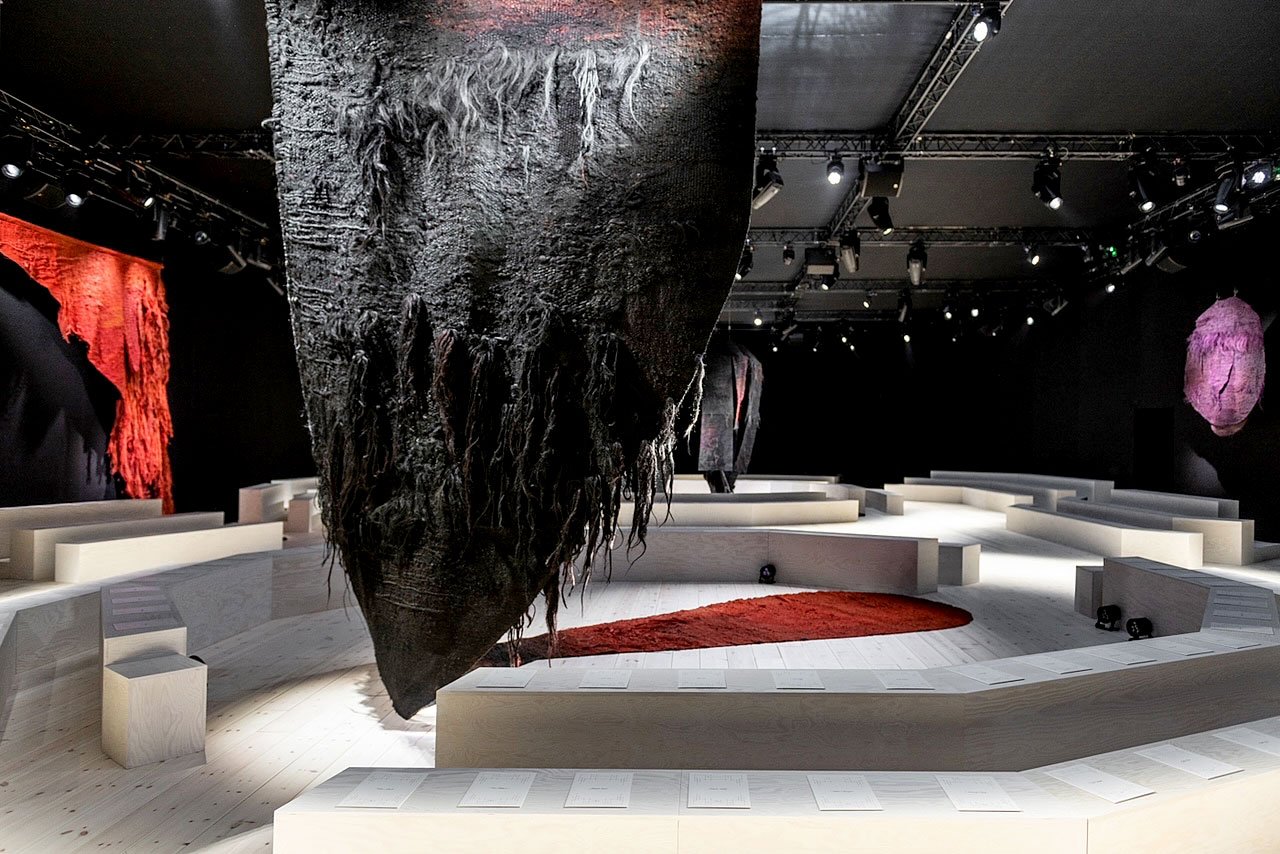
The trailblazing fashion house of Alexander McQueen has always been a fascinating study in contrasts, both during the founder’s tenure and since his death in 2010. It is a wholly original label lauded for its synthesis of opposing forces: strength and fragility, darkness and hope, immortality and vulnerability. Interweaving them into a cohesive vision is the magic of McQueen.
It seems fitting, then, that creative director Sarah Burton—who has helmed the house for the last 13 years since McQueen’s death (and acted as his right hand another 13 years before that)—sought the monumental textiles of the late Polish fiber artist Magdalena Abakanowicz as the set design for her spring 2024 collection in Paris. The show, as it turned out, would be her farewell.
Installation view of Magdalena Abakanowicz at Alexander McQueen, Spring/Summer 2024, Paris. © Alexander McQueen. Photo: Norbert Piwowarczyk.
Burton wanted to put an exclamation mark at the end of her 26-year career at McQueen with five striking woven sculptures by Abakanowicz installed around the show venue, Le Carreau du Temple. She considers Abakanowicz a “transgressive and powerfully creative artist who refused ever to compromise her vision,” she explained in the show notes. Some of these groundbreaking works were accompanied by looks on mannequins that they inspired.
(Kering, Alexander McQueen’s parent company, later announced that Sean McGirr, head of menswear at the U.K. label JW Anderson, will succeed Burton.)
Installation view of Magdalena Abakanowicz at Alexander McQueen, Spring/Summer 2024, Paris. © Alexander McQueen. Photo: Norbert Piwowarczyk.
One particularly monumental piece, Black Garment VI (1976), loomed large in the venue. Handmade from knotty rope and plant sisal, it was created to resemble a shroud worn by a nomad or a priest of yore, said the artist, who, in characteristically mystical parlance, once described black as the color of “mystery, of inside, of night in which you only feel without seeing.”
Some of these giant forms enveloping the runway—which the artist likened to “spiritual shelter”—were recently exhibited at Tate Modern, where Burton discovered Abakanowicz’s work. Now on tour, “Magdalena Abakanowicz: Every Tangle of Thread and Rope” surveys the artist’s early career, when her weavings—dubbed Abakans—first came off the wall and took shape in three-dimensional space, a transformation that elevated fiber sculpture to a recognized art form. By this time, the late 1960s, Abakanowicz had become a proponent of the New Tapestry movement in Europe. Other pieces chez McQueen were loaned from the Central Museum of Textiles in Łódź, Poland, and the Museum of Art and Design in New York.
Installation view of Magdalena Abakanowicz at Alexander McQueen, Spring/Summer 2024, Paris. © Alexander McQueen. Photo: Norbert Piwowarczyk.
Mary Jane Jacob, co-director of the Abakanowicz Arts and Culture Charitable Foundation, served as the artistic advisor for the installation, working directly with Burton. “It’s hard for us today to imagine how transgressive Abakans were in the ‘60s and ‘70s,” she said. “They were towering, bloated, brooding, gnarly—and magnificently beautiful.”
Indeed, each ten meters tall, the two parts of Monumental Composition (1973–75)—seen here for the first time outside of Poland—dwarfed the room. The tightly bound, brilliantly hued coils of Abakan Red (1969) reference the male anatomy, while the circular shape of Abakan Violet (1969) continued the artist’s interest in the female form.
Jacob acknowledged the struggle for recognition that Abakanowicz experienced as a woman artist—especially in a place, Poland, “then considered an artistic backwater,” she said.
Although Abakanowicz did not consider herself a feminist, she imbued her works with fierce self-affirmation and personal conviction—a sentiment long associated with McQueen’s works in fashion, too. As Burton wrote in the notes: “The show is dedicated to the memory of Lee Alexander McQueen, whose wish was always to empower women.”
More Trending Stories: